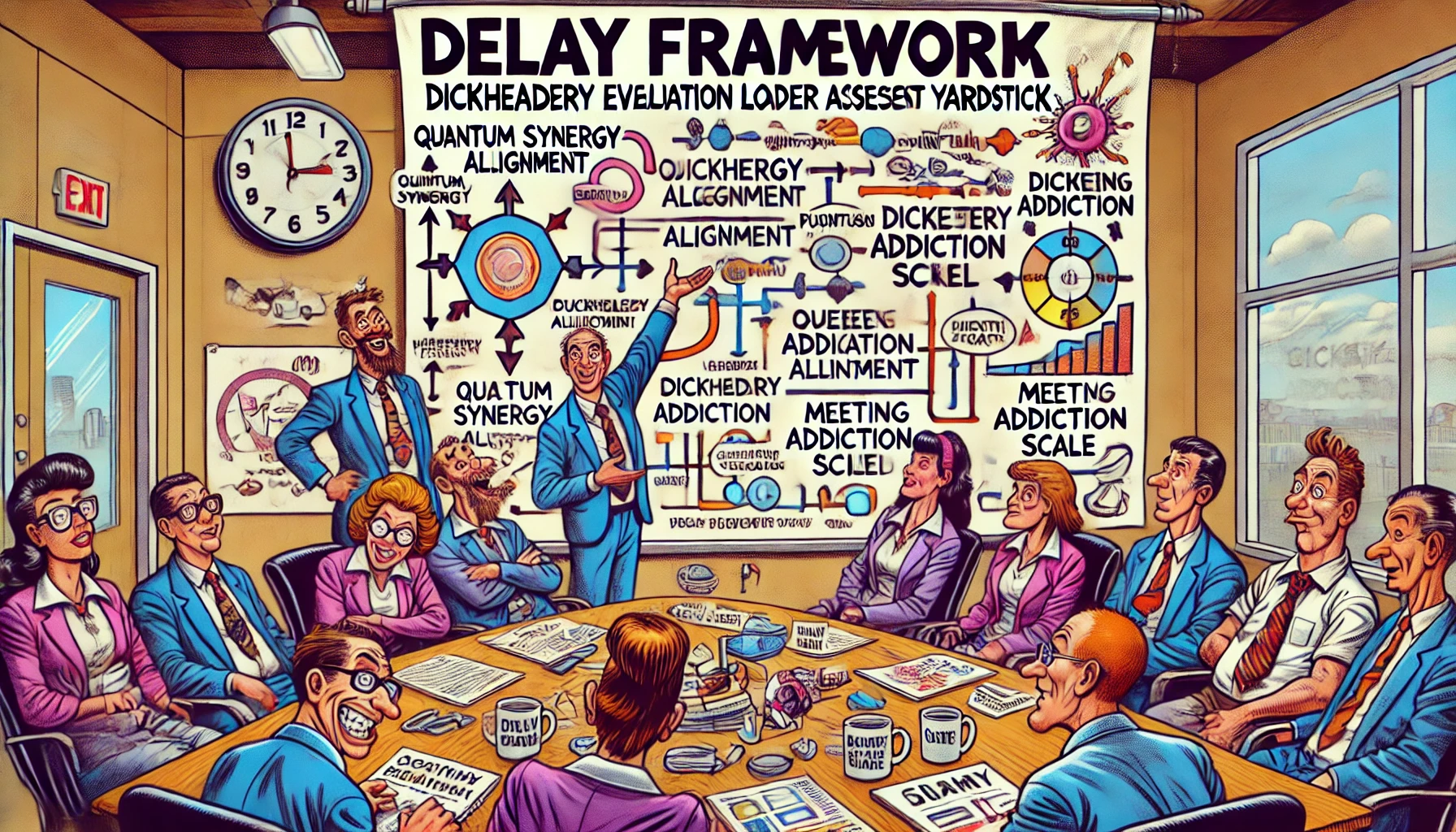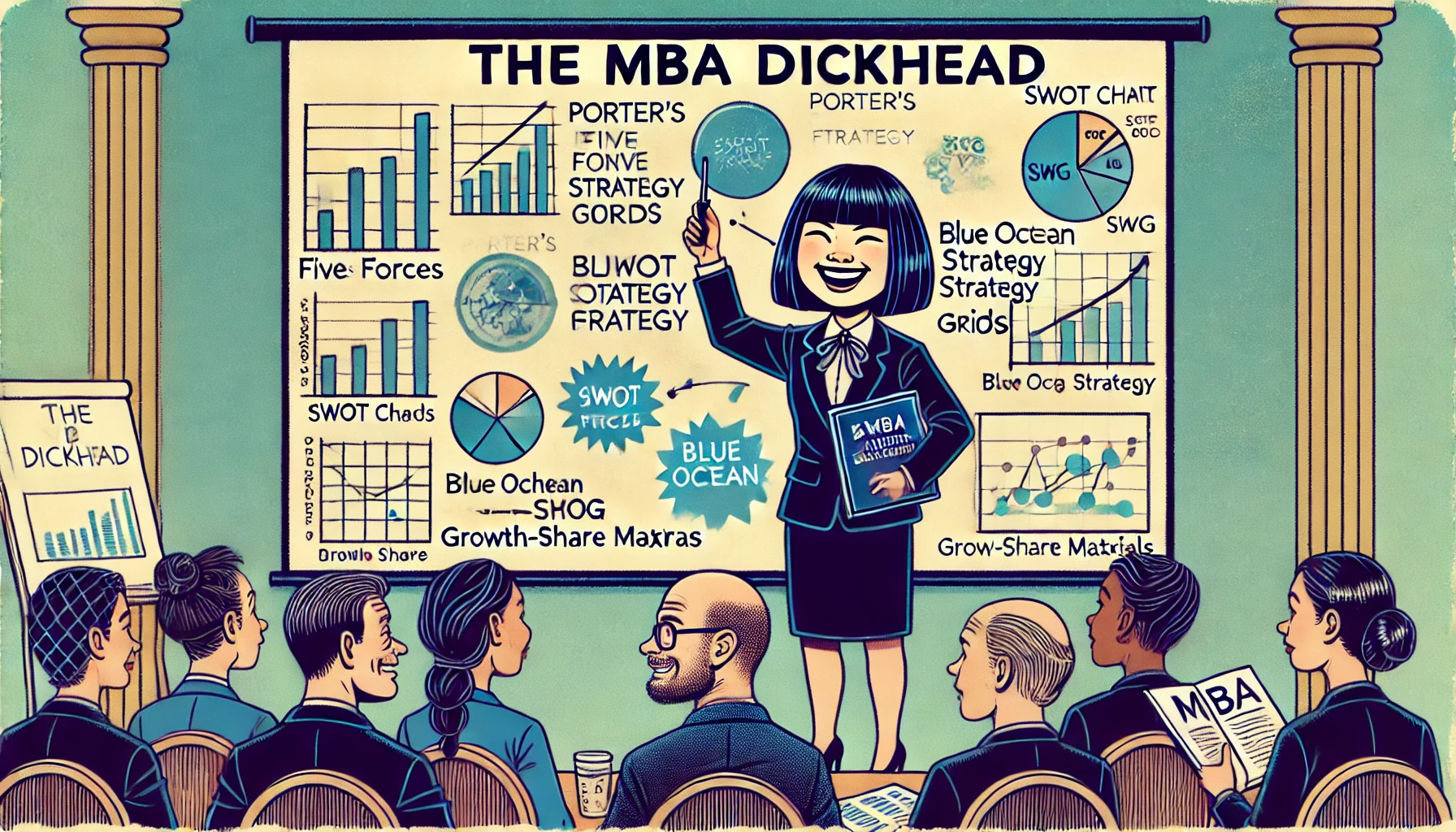The D.E.L.A.Y. Framework™: Revolutionizing Procrastination in Business
A Grand, Overblown Introduction
Prepare to witness a paradigm shift in corporate methodology that will transform the way organizations do absolutely nothing. Introducing the Dickheadery Evaluation Leadership Assessment Yardstick™ (D.E.L.A.Y.), a groundbreaking, earth-shattering framework that promises to synergize your synergy, optimize your optimization, and revolutionize revolution itself. Born from the ashes of countless HR meetings and fueled by buzzwords, D.E.L.A.Y.™ arrives with fanfare, positioning itself as the next big thing in management science. It’s billed as a game-changing, holistic 360° solution to problems you never knew you had – mainly because it invented those problems just to solve them. In short, D.E.L.A.Y. is here to radically change your organization… by ensuring nothing ever really changes at all.
The ‘Scientific’ Principles Behind D.E.L.A.Y.
D.E.L.A.Y. comes draped in the finery of fake science and corporate gobbledygook, assuring everyone it’s grounded in “research” (conducted, of course, by the prestigious Completely Unnecessary Corporate Research Institute™). According to its creators, this framework is backed by cutting-edge principles that sound impressive but mean absolutely nothingwhen examined. Some of the key pseudo-scientific pillars supporting D.E.L.A.Y. include:
- Quantum Synergy Alignment: A principle that alleges delaying decisions actually allows workplace energies to align on a sub-molecular level. (No, we don’t understand what that means either, but it sure sounds profound!)
- Neuro-Linguistic Procrastination (NLP): The art of using big words to postpone action. By peppering conversations with terms like “leverage” and “cascade,” leaders can appear strategically contemplative while effectively doing nothing.
- Multi-Phasic Resource Dilution: A fancy way to justify spreading one simple task across multiple teams and dozens of meetings. This principle insists that a diluted focus is scientifically proven to increase cross-functional cluelessness, which D.E.L.A.Y. treats as a desired end-state.
- Holistic KPI Obfuscation: D.E.L.A.Y. is “data-driven” — it generates heaps of metrics and colorful charts so convoluted that no one can question them. This includes made-up indices like the Narcissism Quotient (NQ) and Meeting Addiction Scale (MAS) that lend an air of credibility while measuring the immeasurable. (Example: “Our proprietary NQ metric uses 12 vague indicators to detect if a candidate is a ‘Total Prima Donna’ or just a ‘Garden-Variety Jerk.’ Science!)
In summary, the scientific foundation of D.E.L.A.Y. is as solid as Jell-O in an earthquake. It dazzles the eye with complex diagrams and Latin terms, allowing executives to nod sagely about “robust methodological frameworks” — all while blissfully ignoring that it’s built on utter nonsense.
Key Components of the D.E.L.A.Y. Framework (Breaking Down the Acronym)
To truly appreciate D.E.L.A.Y.’s brilliance, we must unpack its five absurdly self-important components. Each letter in D.E.L.A.Y. stands for a core concept in this revolutionary framework, redefining common sense into corporate jargon:
- D – Dickheadery: Yes, it’s a technical term. In D.E.L.A.Y.-speak, Dickheadery represents the quantitative measure of corporate obnoxiousness present in a person or process. Rather than tiptoeing around with phrases like “toxic behavior” or “poor cultural fit,” this framework proudly calls it what it is. By treating office jerkiness as a KPI, D.E.L.A.Y. gives the illusion that blustering narcissism is a tangible asset that can be tracked and graphed. This component posits that if you can calibrate someone’s Dickheadery on a 10-point scale, you can manage it (you can’t, but it’s cute that we try).
- E – Evaluation: In the world of D.E.L.A.Y., Evaluation isn’t just any evaluation – it’s an endless, multi-layered assessment loop that makes performance reviews look like speed dating. This involves evaluating the evaluations, appraising each trivial metric with grave importance. D.E.L.A.Y. Evaluation processes are so exhaustive and circular that by the time you finish evaluating, the original issue has long solved itself or been forgotten. The term suggests rigor and objectivity, but in practice it’s about as rigorous as a game of corporate Mad Libs. (Think “Comprehensive Leadership Index Scorecard Analysis” – a.k.a. discussing ad nauseam whether Dave in Sales is a visionary or just annoying.)
- L – Leadership: Slap the word Leadership on anything and it sounds crucial. In D.E.L.A.Y., Leadership is less about guiding teams and more about who to blame when things go awry. This component preaches “top-down commitment”, meaning every manager from team leads to the CEO must embrace D.E.L.A.Y.’s convoluted practices. It creates a cascade of delay — executives delay decisions waiting for manager input, managers delay waiting for executive sign-off. The framework reframes this as “distributed empowerment”, claiming to engage all levels of leadership in active postponement of action. Essentially, D.E.L.A.Y. Leadership means everyone leads by stalling, and no one ever has to take ownership of an actual decision.
- A – Assessment: In D.E.L.A.Y.-land, Assessment is not a single event but a perpetual state of being. Employees and candidates are continuously monitored via pointless quizzes, surveys, and 18-page self-assessment forms, all under the guise of continuous improvement. It’s an Assessment of assessments — evaluating people on how well they conform to the framework itself. (Did you fill out your “personal dickheadery reflection journal” this week?) By drowning the organization in feedback loops and evaluation matrices, D.E.L.A.Y. ensures nothing ever gets done except assessing what hasn’t been done. It’s efficiency through inefficiency, an infinite corporate hamster wheel labeled as “best practice.”
- Y – Yardstick: Finally, we have the Yardstick, the crowning jewel of this framework. Of course, it’s not a simple yardstick — it’s a “Leadership Impact Quantification Yardstick™.” This is the proprietary measurement tool that promises to quantify the unquantifiable. With great fanfare, companies implementing D.E.L.A.Y. roll out elaborate scorecards, pie charts, and 5-color traffic-light dashboards as their Yardstick to measure progress (or lack thereof). The irony is that this Yardstick is infinitely flexible: it can be adjusted to show whatever results leadership wants to see. It’s less a measuring tool and more a rubber ruler—stretching or shrinking to make sure metrics always look on-track. Because of the Yardstick component, a company can proudly claim, “According to our D.E.L.A.Y. yardstick, we have 0% jerk quotient this quarter!” – a meaningless statement that nonetheless earns approving nods in the boardroom.
Each element of D.E.L.A.Y. sounds vaguely legitimate and profoundly important, which is exactly the point. Together, these components create a comprehensive façade of a framework – a beautiful cathedral of buzzwords where serious work would be, if anyone were actually doing any.
Case Study: Applying D.E.L.A.Y. in Hiring and Management
Let’s see how a fictional company might apply the D.E.L.A.Y. framework in practice. Imagine Acme Corp, a mid-size company drowning in its own processes, decides to implement D.E.L.A.Y. to improve hiring and management. The results are, predictably, a masterclass in corporate confusion and inefficiency:
- Acme Corp Forms a D.E.L.A.Y. Task Force: The journey begins with Acme’s executives assembling a cross-functional committee (because nothing says “we’re serious” like a task force). This team spends its first month crafting a 90-slide kickoff PowerPoint extolling the virtues of D.E.L.A.Y. The slides are full of arrows looping in circles, smiling stock-photo employees, and a mission statement that reads: “Leveraging Delays to Optimize Human Capital Acquisition and Alignment.” No one really knows what that means, but it gets a standing ovation at the meeting.
- Redefining the Hiring Process (a.k.a. Making It Absurd): HR, now rebranded as the “Talent D.E.L.A.Y. Department,” overhauls the hiring process. Every job candidate is required to complete a Dickheadery Aptitude Test, a 200-question exam featuring scenarios so abstract even a philosophy major would be confused. (Sample question: “If a team member receives credit for your idea, do you: a) Schedule a synergy meeting to humblebrag, b) Forward the email thread to their boss with a ‘FYI,’ or c) Innovate a paradigm shift to reclaim mindshare?”) Recruiters then run the answers through a proprietary algorithm that assigns each candidate a Composite Dickheadery Score (CDS). Good luck to any candidate scoring too low on dickheadery – they clearly “lack leadership potential” by Acme’s new standards.
- Interview Iterations Ad Nauseam: Candidates who pass the test are subjected to round after round of D.E.L.A.Y.-style interviews. These aren’t normal interviews, but panel synergization sessions. A simple question like “Tell us about yourself” turns into a 45-minute analysis of the candidate’s buzzword usage, eye contact frequency, and willingness to schedule follow-up meetings to answer basic questions. Managers are trained to interrupt with, “Let’s circle back to that later,” just to see how well the candidate handles constant postponement. By design, the most patient and persistently available (read: those with nothing better to do) make it through, while high-quality candidates with actual initiative are driven to frustration and drop out.
- Management by D.E.L.A.Y.: Acme doesn’t stop at hiring – they infuse existing management with D.E.L.A.Y. principles too. They roll out an internal policy that all decisions now require a D.E.L.A.Y. compliance check. For example, when deciding on a new project, managers must fill out a “Leadership Impact and Dickheadery Alignment Worksheet” to ensure the plan aligns with the framework’s criteria. This involves rating the idea on a 10-point scale of possible confusion, predicting how many pointless meetings it could generate, and identifying opportunities to blame others if it fails. The approval process now takes an extra six weeks for every minor decision. Productivity plunges, but hey, the paperwork looks great!
- Outcomes and Chaos (Rebranded as Success): After six months of D.E.L.A.Y. implementation, Acme Corp’s hiring is at a standstill and management has effectively ground to a halt. The best job candidates have long since accepted offers elsewhere, and current employees spend more time filling out surveys and forms than doing actual work. But in the quarterly town hall, the CEO proudly reports, “Thanks to D.E.L.A.Y., we have achieved unprecedented levels of process alignment!” The management team presents a bar graph “proving” that workplace dickheadery is down 57% (no one can explain how they calculated that, but it sure looks impressive on the slide). The confusion and inefficiency reigning at Acme are spun as signs of deep strategic introspection and careful planning. In other words, the company is patting itself on the back for being more disorganized than ever, believing this means the framework is working.
This exaggerated case study shows D.E.L.A.Y. in full swing: a company enthusiastically tying itself in knots. By applying the framework to every facet of hiring and management, Acme Corp successfully achieves exactly what D.E.L.A.Y. was designed for – the appearance of improvement and plenty of delay, with none of that messy “solving real problems” nonsense. It’s confusion elevated to strategy, inefficiency masquerading as innovation, a true win-win (for everyone except those who value time).
Optimizing D.E.L.A.Y. to Avoid Real Issues
One of the greatest strengths of the D.E.L.A.Y. framework is its ability to help companies never actually deal with real workplace issues. In fact, with a few tweaks, an organization can optimize D.E.L.A.Y. to become an impenetrable shield against productivity. Here’s how companies can dial up the D.E.L.A.Y. to 11:
- Multiply the Meetings: If you think one meeting could resolve something, schedule five. Label them as “D.E.L.A.Y. Alignment Touchpoints.” The key is to ensure that by the time a decision might be made, everyone is too exhausted or confused to remember what the issue was. Pro tip: Always end a meeting by scheduling a “follow-up sync” to keep the delay momentum going.
- Over-Engineer the Metrics: Don’t settle for simple performance indicators when you can have dozens of overlapping, contradictory metrics. Introduce new D.E.L.A.Y. KPIs like “Workplace Ambiguity Tolerance” and “Action Postponement Index.” The more graphs and numbers, the easier it is to argue that addressing an issue needs more data. By the time anyone figures out what the metrics mean (if ever), the problem has either fixed itself or been replaced by a new problem.
- Institute a D.E.L.A.Y. Approval Bureaucracy: Create a special department (perhaps the Office of Strategic Delay Optimization) that must sign off on any action whatsoever. This office’s job is ostensibly to ensure “alignment with D.E.L.A.Y. principles,” but really it’s there to ask for more documentation, more forms, and then go on vacation. Nothing escapes its black hole of approval. This virtually guarantees that pesky real issues never see the light of day because they’re stuck in D.E.L.A.Y. purgatory.
- Rebrand Problems as “Pending D.E.L.A.Y. Initiatives”: Toxic team culture? Under D.E.L.A.Y., it’s not a problem – it’s a “cultural realignment initiative currently in D.E.L.A.Y. phase.” Incompetent manager wreaking havoc? No, they’re “undergoing D.E.L.A.Y.-guided leadership enhancement.” By renaming every real issue as part of the D.E.L.A.Y. process, you give the illusion that anything and everything is under control and being “handled” (albeit very slowly). This semantic trick ensures you never have to directly address the issue; it’s safely couched in D.E.L.A.Y. terminology.
- Celebrate Delay Victories: Finally, cultivate a culture that rewards postponement. Did a team push a deadline three times because of additional D.E.L.A.Y. reviews? Throw a mini celebration – they are demonstrating “commitment to the process.” Did an employee spend an entire week perfecting a D.E.L.A.Y. report nobody will read? Promote them as an “Operational Excellence Champion.” By positively reinforcing the avoidance of real work, you ensure that dealing with actual problems becomes culturally discouraged. After all, why solve today what you can D.E.L.A.Y.™ until next quarter?
By optimizing these aspects, companies effectively create a safe bubble of inertia. D.E.L.A.Y. becomes not just a framework but a way of life – a corporate Zen state where no tough decision is ever made, no toxic behavior is directly confronted, and no basic common-sense solution is implemented without at least a dozen meetings and a PowerPoint deck. It’s procrastination institutionalized, all under the comforting guise of a fancy management system.
Conclusion: Impressive-Sounding, Utterly Useless – and Coming to a Corporation Near You
In conclusion, the D.E.L.A.Y. Framework™ is the ultimate triumph of style over substance in the business world. It manages to be utterly useless while sounding ultra-impressive – a combination that, paradoxically, virtually guarantees its adoption by major corporations everywhere. After all, what CEO wouldn’t be enticed by a methodology with such a grandiose name and an accompanying 90-slide PowerPoint deck full of colorful charts and uplifting slogans?
D.E.L.A.Y. succeeds not because it solves problems (it doesn’t), but because it brilliantly caters to the corporate desire for impressive jargon and blame-deferring processes. It provides cover for inaction and a platform for endless pontification. In the boardroom, executives can proudly say, “We’ve implemented a state-of-the-art leadership assessment program,” while glossing over the fact that it’s basically a high-priced stalling tactic. And let’s face it, in the land of corporate nonsense, if something sounds complicated enough, people will assume it’s genius.
So brace yourselves: even though D.E.L.A.Y. is a satirical farce of a framework (one that creates more problems than it could ever hope to solve), don’t be surprised when you see it featured in business magazines, hear it praised in keynote speeches, and watch as companies trip over themselves to embrace it. In the end, the DELAY framework proves one thing: when it comes to corporate fads, appearance beats reality every time. And if you can dazzle with acronyms and delay actual work indefinitely, you just might be on the cutting edge of the next big managerial revolution – however pointless it may be.



